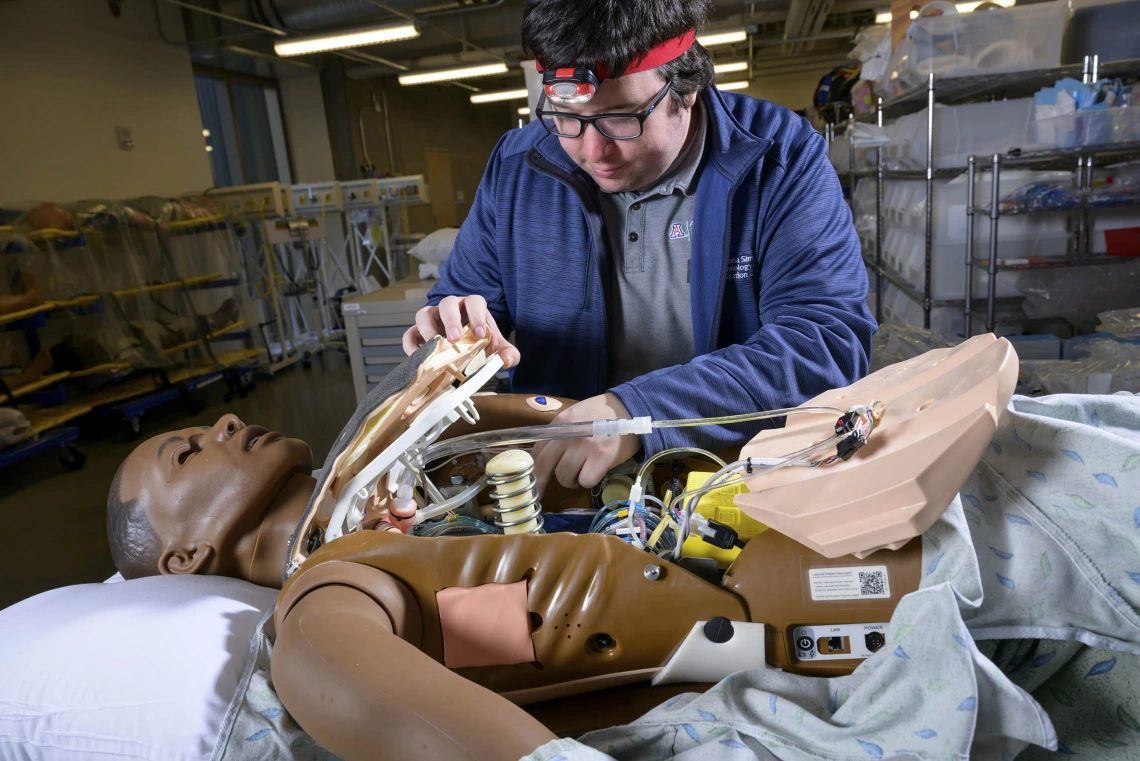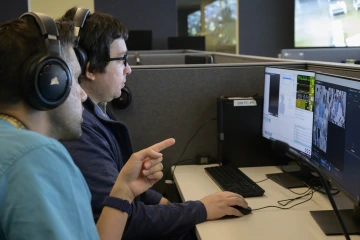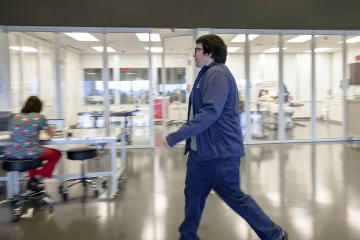Lucas Grijalva sets the stage for learning
ASTEC specialist is the man behind the innovative technology that helps future health-care providers prepare for real life.

Lucas Grijalva makes sure the electronic components inside ASTEC’s manikins are in working order for student simulations.
Lucas Grijalva stares intently at the pair of computer screens in front of him. He taps on the keyboard and watches the numbers in the upper-right-hand corner jump. On the other monitor, he watches the medical students’ reactions as their patient’s blood pressure spikes to 168/96.
“Your blood pressure is a little high,” one woman tells the “patient,” a manikin, during the training exercise at the Arizona Simulation Technology & Education Center at the University of Arizona Health Sciences.

From the control room, Lucas Grijalva can monitor the simulation room and change the patient simulator’s responses to students’ interventions.
This afternoon’s scenario is about treating chest pains. Grijalva hits another key and the patient’s vitals nosedive. The students take turns doing CPR.
“They’re not pushing deep enough,” Grijalva says, as he watches the screen evaluating the pressure of the compressions.
If ASTEC is the Land of Oz, Grijalva is one of the people behind the curtain. But unlike the Wizard of Oz, you will want to pay attention to him.
ASTEC’s SimDeck – essentially a two-story, Hollywood-esque sound stage – has reconfigurable rooms and a virtual environment that can mimic situations that health care providers or first responders might encounter. Grijalva, simulation operations specialist, makes sure the technology – whether it’s computers or the electronic components inside the human patient simulators – are updated and working.
Before he starts a simulation, Grijalva preps rooms and makes sure everything is in working order. During the exercise, he programs how the manikin reacts, monitors what happens and helps educators with their debriefings. He also walks the floor like the consummate good host, checking rooms to make sure everyone has what they need. He’s often a tour guide as well.
“As much as we plan and try to keep things organized, something always happens. I’m very good at improvising.”
Lucas Grijalva, ASTEC simulation operations specialist
For Grijalva, a certified nursing assistant who graduated from UArizona with a Bachelor of Arts degree in information science and eSociety, working at ASTEC blends his interests perfectly.
Playing to strengths
Grijalva, the middle of three sons, grew up in Douglas, Arizona. His grandfather, George Spikes, was a doctor, and his grandmother, Lucia, a nurse.
Grijalva, who loves video and strategy games, became a certified nursing assistant at 18 and thought he’d follow in their footsteps and study medicine, but he just didn’t have the passion for it. Everything clicked with tech and computers, though.

For Lucas Grijalva, working in ASTEC brings together his interests in technology and medicine.
After graduation, Grijalva was working at UArizona Student Unions in the games room when he found out about the position at ASTEC. Compared to today’s spacious, state-of-the-art facility within the Health Sciences Innovation Building, the center back then felt like “a broom closet,” Grijalva joked.
He still remembers his first day on the job when an emergency medicine clerkship took over the space. It was chaotic and cramped … and far from boring.
“I think that’s my favorite part – it’s always interesting,” Grijalva said, smiling.
You never know what could pop up.
“As much as we plan and try to keep things organized, something always happens,” he said. “I’m very good at improvising.”
During one recent training session in which students were learning how to conduct a neurological test, one of the manikin’s eyes got stuck closed. The students mistakenly thought it was part of the scenario. Another time, a co-worker called Grijalva to check out a malfunctioning manikin that had a sheet draped over it, only to walk over and have an actual human hand fly out from beneath the cover and grab his leg. It was April Fool’s Day.
“It was so funny,” he said. “I was so mad. It scared the bejesus out of me.”
Hijinks aside, keeping your cool in what’s often a pressure-cooker situation is a valuable skill that Grijalva has down, said David Biffar, MS, ASTEC’s director of operations.
“You have to be able to improvise and not overreact,” Biffar said. “We’re eliciting a lot of stress from the students, they don’t need to see the support staff exhibiting a loss of control, too.”
Training for the future
Grijalva says the ASTEC crew is close-knit, and they never lose sight of how important their work is. Students often come back and tell Grijalva and his co-workers that they experienced cases at the hospital that mimicked their exact ASTEC scenarios.

The best part of his job, Lucas Grijalva says, is that it’s never boring.
“It’s very cool to see that crossover,” he said. “This is the stuff they're going to see in real life.”
Grijalva said he’s proud to be a part of a team offering such next-level training for future health care providers. Years ago, medical students would learn by watching experienced professionals perform procedures. At ASTEC, students get hands-on practice. They can inject medication or manage a compromised airway on manikins and perfect their techniques multiple times before facing it in real life.
“They can do it over and over again until they feel comfortable,” he said. “When they see a real person at the hospital, they can actually feel confident and know what they're doing. We’re making a difference out there.”
Grijalva says he can’t imagine ever working anywhere else.
“I've never had a day where I've dreaded waking up and going to work,” he said. “I’ve honest to God never had a day where I thought, ‘I don’t want to do this.’ It’s such a fun thing.”

